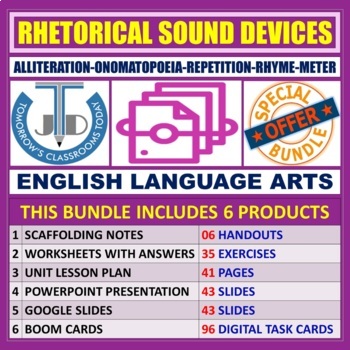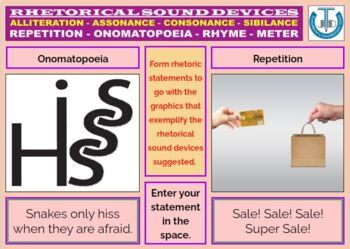SOUND DEVICES - ALLITERATION ONOMATOPOEIA REPETITION RHYME METER: BUNDLE
- Zip

Products in this Bundle (6)
showing 1-5 of 6 products
Description
These bundled resources are perfect for teaching Rhetorical Sound Devices - Alliteration, Assonance, Consonance, Sibilance, Onomatopoeia, Repetition, Rhyme and Meter. These no prep activities would be great for English lessons or English centers. Your students will love these ELA Boom Cards, Google Slides, PPT, Unit Plans, Worksheets and scaffolding notes.
After attempting these New Bloom’s Taxonomy based activities students will be able to:
- Match the terms associated with rhetorical sound devices with their meanings.
- Identify the words that exemplify the rhetorical sound devices in the text.
- Form rhetoric statements to go with the graphics that exemplify the rhetorical sound devices.
- Interpret the rhetorical sound devices used in the text and explain the author’s purpose in using them.
- Identify the impact of the use of rhetorical sound devices in the given text.
- Analyse the given text to interpret the rhetorical sound devices used in them.
This download includes:
- Scaffolding Notes: 6 Handouts
- Worksheets with Answers: 35 Exercises
- Unit Lesson Plan: 41 Pages
- PowerPoint Presentation: 43 Slides
- Google Slides: 43 Slides
- Boom Cards: 96 Digital Task Cards
Here are some possible uses for these in your classroom:
- To challenge early finishers
- For effective tutoring
- As ESL stations and sub tubs
- As holiday work and homework
- For small group collaborations
- For an end of unit assessments
- For reinforcement and enrichment
◈◈◈◈◈◈◈◈◈◈◈◈◈◈◈◈◈◈◈◈◈◈◈◈◈◈◈
Save 30% on this BUNDLE!
Note: These are also sold separately!
◈◈◈◈◈◈◈◈◈◈◈◈◈◈◈◈◈◈◈◈◈◈◈◈◈◈◈
More Figurative Language Resources by the same Author:
- RHETORICAL COMPARISON DEVICES - BUNDLE
- RHETORICAL SOUND DEVICES - BUNDLE
- PERSONIFICATION - BUNDLE
- OXYMORON - BUNDLE
- IRONY TYPES - BUNDLE
- ELEGY - BUNDLE
- IMAGERY TYPES - BUNDLE
- SYNECDOCHE VS METONYMY - BUNDLE
Customer Tips: How to get TPT credit to use for future purchases
- Follow me HERE to get notified of updates, sales, free resources and new products.
- Please go to your My Purchases page (you may need to log in). Beside each purchase, you'll see a Provide Feedback button. Simply click it and you will be taken to a page where you can give a quick rating and leave a short comment for the product.
- Each time you give feedback, TPT gives you feedback credits that you use to lower the cost of your future purchases.
- I value your feedback greatly as it helps me determine which products are most valuable for your classroom so I can create more for you.
- Look for the green star next to my store logo and click it to become a FOLLOWER. You will now receive email updates about this store. Be the first to know about my new discounts, freebies and product launches.
This is what teachers say about these resources:
- READING TO UNDERSTAND DIFFICULT TEXTS BUNDLE - Jessica Curley: This has been a useful resource to come back to as we progress. Rating: 5/5 (extremely satisfied)
- PUNCTUATION HANDOUTS BUNDLE - Renee Forche: I used this resource with my sixth graders to assess their knowledge. Rating: 4/5 (very satisfied)
- WRITING A BIOGRAPHY: BLOOM'S TAXONOMY BASED RESOURCES - BUNDLE - Renee Forche: Good resource when teaching my biography unit. Rating: 4/5 (very satisfied)
- IDIOMS: BLOOM'S TAXONOMY BASED RESOURCES - BUNDLE - Karuna Russell: Initially, I struggled with navigating it. I finally figured out how to use this with my students virtually. It actually worked well with them. Idioms are extremely difficult for my population and this product did a great job supporting them. Rating: 5/5 (extremely satisfied)
- READING COMPREHENSION: BUNDLE - Kristen Mason: "Ton of information... great to pick and choose. It was great at-home reinforcement for my kid." Rating: 4/5 (very satisfied).
- PLAYSCRIPT WRITING - CLASSROOM RESOURCES - BUNDLE - k h: "Literally perfect and exactly what I needed. I hope there is more to come. It covers so much. Awesome. I wish the ppt design was a little more colorful or themed." Rating: 5/5 (extremely satisfied)
- RHETORICAL DEVICES IN A SPEECH BUNDLE - Rebecca Liford-Hibbard: "Although this wasn't exactly what I expected, it worked our really great for my unit on Rhetoric. I particularly liked the charts and the breakdown of the various techniques used to achieve strong Rhetoric." Rating: 4/5 (very satisfied)
- PUNCTUATION WORKSHEETS WITH ANSWERS BUNDLE - Kaylin Johnson: That resource was good. The formatting was not super user friendly. There were also a couple of typos within the resource. That being said, I did use this a lot and it did help my students master the concepts. Rating: 4/5 (very satisfied)
- STORY SETTING BUNDLE - Ann Cunningham: Standards aligned. Rating: 4/5 (very satisfied)
- PREPOSITIONAL PHRASE: BUNDLE - Angela daSilva: Used with an online student. A lot of good information is in this resource. Rating: 4/5 (very satisfied)
- AUTOBIOGRAPHY WRITING BUNDLE - Great resource to use to extend the higher writers. - zoe albrecht. Rating: 4/5 (very satisfied)
- STORY SETTING BUNDLE - We are gearing up to do a big narrative writing project in distance learning, and this resource was excellent for helping the kiddos get a better understanding of setting! - Teach 'Em Nerdy. Rating: 5/5 (extremely satisfied)
- KING LEAR - SHAKESPEAREAN TRAGEDY - CLASSROOM RESOURCES BUNDLE - Great resource for Lear. - ME In 203. Rating: 5/5 (extremely satisfied)
- IRONY TYPES BUNDLE - I have a lot of his resources and love them. He includes activities to address various abilities and skill levels. - Denise Hickey. Rating: 5/5 (extremely satisfied)
- PARAGRAPH WRITING - CLASSROOM RESOURCES - BUNDLE - My students struggle with writing a paragraph. This resource was great for building their writing skills. - Denise Hickey. Rating: 4/5 (very satisfied)
- ARGUMENTATIVE WRITING - CLASSROOM RESOURCES - BUNDLE - This is a great resource. He provides scaffolding activities to address various ability levels. - Denise Hickey. Rating: 4/5 (very satisfied).
- DEBATING SKILLS BUNDLE - Rating: 5/5 (extremely satisfied) - "This is a great process to learning debating skills. Our unit culminated in 2 class debates and successfully utilize the skills introduced in this resource." - Christine O'Shea.
- VERBAL PHRASES: TEACHING AND LEARNING RESOURCES - BUNDLE - Thank you for providing such detailed lesson plans and practice. - Elizabeth Green
- PARAGRAPH WRITING - CLASSROOM RESOURCES - BUNDLE: A thorough and informative resource. I found it a bit confusing at times, as there is a lot of information to take in, but I appreciate the variety of colors to separate examples. A very thorough resource that is useful! - Briana Vaskic
- SUMMARY WRITING - CLASSROOM RESOURCES - BUNDLE - I adore how organized this guy is! This was a great resource for my 6 and 7-grade students. - Matthew Bourne
- CLAUSES LESSONS AND RESOURCES: BUNDLE - Good additional resource for my kiddos. - Jo Pillsbury
- ARGUMENTATIVE WRITING - CLASSROOM RESOURCES - BUNDLE - Very thorough, but not very "kid-friendly". I would recommend using with older students. - Mandi Esparza
- SKIMMING SCANNING READING BUNDLE" - Another great tool to use for students to skim and scan material! - Stephanie Zweifel.
- IMAGERY TYPES BUNDLE - Was way more detailed than I thought it would be. Took a little bit to go through all of it, but a great resource for sure. I will definitely use this as we dig deeper into imagery. - Metasha Olson.
- ADVERBIAL PHRASE: BUNDLE - Great, easy-to-use resource! - Gemma Creed
- DESCRIPTIVE WRITING: BUNDLE - It helped me create my writing lessons! - Ewelina Pykosz
- NOTE TAKING BUNDLE: I will be using this to teach notetaking to my ELD kids. - Melinda Stewart
- STORY ANALYSIS HANDOUTS BUNDLE: Looking forward to using this extensively in all levels of my classes. - Olivia Fulmer.
- STORY ANALYSIS LESSONS AND RESOURCES BUNDLE: I'm using this for the English II short story unit. - Olivia Fulmer
- SENTENCES LESSONS AND RESOURCES BUNDLE: Very thorough. These cover all the areas of need for sentence types and structures. - Steelers Fan
- HOMOPHONES-HOMONYMS-HOMOGRAPHS BUNDLE: A great resource for my kids to practice!!! - Rebecca Thorman
- PREFIXES AND SUFFIXES BUNDLE: This is a superb resource for review. - Kay Crawford
- COMPOUND-COMPLEX SENTENCES BUNDLE: It's hard to find a good compound-complex sentence resource. - Carrie Taylor
- SKIMMING SCANNING READING BUNDLE: Good for higher-level classes that run as more discovery learning. - Jamie B.
- AUTOBIOGRAPHY WRITING BUNDLE: A very strategic resource! - A Buyer
- POSTER DESIGN BUNDLE: It was nice to find a resource that shows students basic guidelines for any poster. - Amber Finch
- PHRASES AND CLAUSES HANDOUTS: BUNDLE - Extremely resourceful and helpful. - Sherine Salaheldin
- NOTE TAKING BUNDLE: Excellent resource! It has been a real help in showing my students how to take notes! - Nancy Bates
- WRITING WORKSHEETS AND TASK CARDS BUNDLE - This resource more than delivers! A wide range of very useful, practical and easy to teach writing examples and lesson plans. - Teresa Ruhde
- ARTICLES/DETERMINERS: BUNDLE - A complete resource on articles. It will be helpful for ESL students who struggle with articles. - Karen Koehler
Find Me Here:
- TPT Store - JOHN DSOUZA
- Pinterest - JOHN DSOUZA
- Facebook - TOMORROW’S CLASSROOM TODAY
- Instagram - JOHN421969
- Twitter - JOHN421969
- Boom Learning - JOHN DSOUZA





